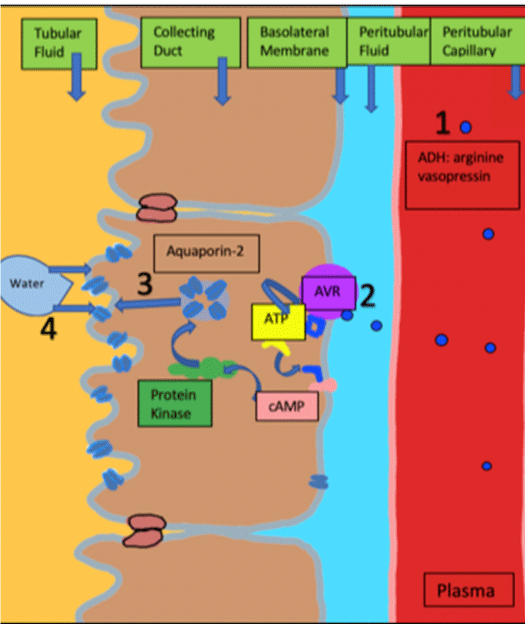
Case Presentation
Austin Crit Care J. 2022; 9(1): 1043.
Hypercalcemia Induced Nephrogenic Diabetes Insipidus with Symptomatic Hypernatremia
Bradford CM¹* and Samra J²
1Malcolm Fisher Department of Intensive Care Medicine. Royal North Shore Hospital, Australia
2Department of Gastrointestinal Surgery, Royal North Shore Hospital, Australia
*Corresponding author: Celia M Bradford, Malcolm Fisher Department of Intensive Care Medicine. Royal North Shore Hospital, Sydney, Australia
Received: June 28, 2022; Accepted: July 25, 2022; Published: August 01, 2022
Abstract
Nephrogenic Diabetes Insipidus (NDI) can be acquired or congenital. There is an inability of the kidney to concentrate urine owing to the insensitivity of the distal nephron-collecting duct to the antidiuretic hormone, arginine vasopressin. The diagnosis is made with a water deprivation test and patients will have inappropriately low urine osmolarity and sodium despite water deprivation. Causes of acquired nephrogenic diabetes insipidus include chronic lithium ingestion, hypercalcemia and hypokalemia.
Case Presentation
A 77-year old woman underwent laparotomy and left lateral hepatic sectionectomy, partial gastrectomy, distal pancreatectomy and splenectomy for a large (20cm) friable intra-abdominal mass [1,2]. Her background was remarkable for Hypertension, Type II Diabetes and Hypercholesterolemia. Pre-operatively she was normonatremic but hypercalcemic likely due to the intra-abdominal malignancy [3]. The histopathology on the specimen confirmed a poorly differentiated sarcomatoid carcinoma (Figure 1).

Figure 1: The posterior pituitary gland releases the Antidiuretic Hormone
(ADH), Arginine Vasopressin (AV) into the blood stream. It binds to the
ADH receptor (or AV receptor) at the basolateral membrane sparking a
series of events, which leads to the production of the Aquaporin-2 (AQP2)
receptors, which insert into the apical membrane. These regulate waterreabsorption
at the apical membrane to facilitate urinary concentration.
Chronic hypercalcemia causes reduced expression of the proteins that form
the AQP2 receptor and receptor autophagy to diminish the nephron’s ability
to concentrate urine.
In the peri-operative period she was made nil by mouth (effectively a water deprivation test) but was retrospectively noted to be passing large volumes of dilute urine [4]. She was commenced on intravenous fluids and transitioned onto TPN (Table 1). On the fourth postoperative day, she became confused, tremulous, hyper-reflexic and agitated and was found to have developed profound hypernatremia and worsening hypercalcemia. Urine osmolarity confirmed an inappropriately dilute urine and a diagnosis of hypercalcemic nephrogenic diabetes insipidus was made. She was rehydrated, the TPN changed to electrolyte-free solution and her neurological status improved as did her metabolic profile.
Pre-op
Day 0
Day 2
Day 4
Day 6
Cac (mmol/L)
2.7
2.67
2.83
3.09
2.82
Corrected Cai (mmol/L)
1.45
1.57
1.65
1.56
Na+ (mmol/L)
133
140
148
167
153
Cr (umol/L
133
107
126
98
77
Urine osmolarity (mmol/kg)
288
Unine Na+ (mmol/L)
35
Table 1: Peri-operative Period.
Mechanism of Hypercalcemic Acquired Nephrogenic Diabetes Insipidus
Chronic hypercalcemia causes downregulation of collecting duct AQP2 expression. This may be due to autophagy of the AQP2 receptor. Additionally, there can be a significant down-regulation of the Na-K-2Cl cotransporter in the medullary thick ascending limb, thereby interfering with the counter current mechanism and this may participate in the development of the urinary concentrating defect [5].
Discussion
There have been seven different types of aquaporins identified in the kidneys. The Aquaporin-2 subtype (AQP2) has been shown to be the primary target for vasopressin regulation of collecting duct water permeability. Vasopressin is released from the posterior pituitary gland [6]. It binds to the vasopressin-type 2 receptor on the basolateral membrane of the collecting duct. This causes production of aquaporins, which insert into the luminal/apical membrane. These allow water reabsorption and concentration of the urine.
References
- Khana A. Acquired nephrogenic diabetes insipidus. Semin Nephrol. 2006; 26: 244-248.
- Nielson S, Froklaer J, Marples D. Aquaporins in the kidney: From molecules to medicine. Physiol Rev. 2002; 82: 205-244.
- Berl T. The cAMP system in vasopressin-sensitive nephron segments of the vitamin D-treated rat. Kidney Int. 1987; 31: 1065.
- Sands JM, Naruse M, Baum M. Apical extracellular calcium/polyvalent cationsensing receptor regulates vasopressin-elicited water permeability in rat kidney inner medullary collecting duct. J Clin Invest. 1997; 99: 1399.
- Khositseth S, Charngkaew K, Boonkrai C. Hypercalcemia induces targeted autophagic degradation of aquaporin-2 at the onset of nephrogenic diabetes insipidus. Kidney Int. 2017; 91: 1070.
- Wang W, Kwon TH, Li C. Reduced expression of Na-K-2Cl cotransporter in medullary thick ascending limbs in vitamin D-induced hypercalcemia in rat. Am J Physiol. 2002; 282: 34-44.